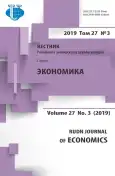Overview of iron and steel industry in China in the 20th and 21st centuries: what are the main steps of its development?
- Авторлар: Groysburt V.S.1, Maslov A.A.1
-
Мекемелер:
- National Research University “Higher School of Economics”
- Шығарылым: Том 27, № 3 (2019)
- Беттер: 551-562
- Бөлім: INDUSTRIAL ORGANIZATION MARKETS
- URL: https://journal-vniispk.ru/2313-2329/article/view/342867
- DOI: https://doi.org/10.22363/2313-2329-2019-27-3-551-562
- ID: 342867
Дәйексөз келтіру
Толық мәтін
Аннотация
Speaking about the XX century after the establishment of People's Republic of China in 1949 the leading trade partner of the country was Soviet Union and after the crisis in Chinese-Soviet relations in the 1960s there has been a shift towards the trade within Asian region, which once again shows that China has always been an active player on the international market because of its productions' power. The way China interacts with other regions and particular countries is an exciting topic for international relations scientists because it reflects the state of affairs of China at every step of its development. For more than 50 years, the Russian metallurgical industry has been building its relationships with China as one of the leading partners. So because Russia has passed through a stage of stagnation after the collapse of the USSR and the period of finding a new balance due to reduced domestic Russian demand, it was crucial to continue developing relations with the closest neighbors and try to catch up. However, why is international trade developing so fast? This happened as a result of the growing purchasing power of the Chinese population; domestic manufacturers are increasing their operations within the domestic market, which is making the country known for being the manufacturer of the world, in its factory. Ferrous metallurgy is used in engineering, construction, and automotive, that is, in critical sectors of the economy. Therefore, scientists and analysts pay great attention to the steel industry and its research. In order to understand the modern state of affairs in the iron and steel industry in China, authors provide an overview of the industry itself using various sources of data, such as historical review and collection of quantitative data, estimate its development to understand its weak and sharp points for the business development.
Негізгі сөздер
Авторлар туралы
Vlada Groysburt
National Research University “Higher School of Economics”
Хат алмасуға жауапты Автор.
Email: vlada-95@mail.ru
graduate of MA programme “Socioeconomic and Political Development of Modern Asia”, Faculty of World Economy and International Affairs
11 Pokrovskii Blvd., Moscow, 109028, Russian FederationAlexey Maslov
National Research University “Higher School of Economics”
Email: amaslov@hse.ru
Ph.D. in World History, Professor in History, Head of School of Asian Studies
11 Pokrovskii Blvd., Moscow, 109028, Russian FederationӘдебиет тізімі
- BP Global. (2018). BP’s Statistical Review of World Energy. https://www.bp.com/content/ dam/bp/en/corporate/pdf/energy-economics/statistical-review/bp-stats-review-2018-fullreport.pdf (accessed: 10.08.2019).
- China Federation of Logistics and Purchasing. http://www.chinawuliu.com.cn/ (accessed: 10.08.2019).
- China Iron and Steel Industry Association. (2018). Annual statistical bulletin. http://english. chinaisa.org.cn/do/index.jsp (accessed: 10.08.2019)
- Chinese steel production to slow sharply in 2018. Financial Times. https://www.ft.com/ content/7dfb918e-f087-11e7-b220-857e26d1aca4 (accessed: 10.08.2019).
- Congressional Research Service. China’s Steel Industry and Its Impact on the United States: Issues for Congress. https://fas.org/sgp/crs/row/R41421.pdf
- Dua Z., Lin B. (2018). Analysis of carbon emissions reduction of China's metallurgical industry. Journal of Cleaner Production, (176), 1177-1184. doi: 10.3390/su11010226 (acces- sed: 10.08.2019)
- Economics Committee World Steel Association. (2017). Steel Statistical Yearbook 1994. https:// www.worldsteel.org/en/dam/jcr:3e275c73-6f11-4e7f-a5d8-23d9bc5c508f/Steel+Statistical+ Yearbook+2017.pdf (accessed: 10.08.2019)
- Economics Committee World Steel Association. (2017). Steel Statistical Yearbook 2018. https:// www.worldsteel.org/en/dam/jcr:3e275c73-6f11-4e7f-a5d8-23d9bc5c508f/Steel+Statistical+ Yearbook+2017.pdf (accessed: 10.08.2019)
- Ferriola J. Steel success strategies keynote presentation. Fastmarkets AMM. https://www.amm.com/ events/amm-steel-success-strategies/presentations.html (accessed: 10.08.2019)
- Gao Y., Hu A. (2009). A comparative study of the development mode of China's iron and steel industry. Journal of Chinese Economic and Business Studies, 7(3), 283-297. doi: 10.1080/ 14765280903073090
- General Administration of Customs of People’s Republic of China. http://english.customs. gov.cn (accessed: 10.08.2019)
- Global Information, Inc. (2017). China Iron and Steel Industry Monthly Report. https:// www.giiresearch.com/report/cccm421245-china-iron-steel-industry-monthly-report.html (accessed: 10.08.2019)
- Jiang Jinhe, Wu Bin. (2010). Current situations on low carbon economy models and discussion on several relevant theoretical issues. Resources science, 32(2), 242-247
- Lin B., Wang X. (2015). Carbon emissions from energy-intensive industry in China: Evidence from the iron & steel industry. Renewable and Sustainable Energy Reviews, (4), 746-754. doi: 10.1016/j.rser.2015.03.056
- Liu H. (2013). Analysis and suggestions on the lower profitability of China’s steel industry. China Steel, (10), 11-18
- Lu Zhongwu, Cai Jiuju, Yu Qingbo, Xie Anguo. (2000). The influences of materials flows in steel manufacturing process on its energy intensity. Acta Metall Sin, 36(4), 370-378
- Song L. et al. (2016). China's New Sources of Economic Growth. Vol. 1. ANU Press
- The National Bureau of Statistics of the Government of China. http://www.stats.gov.cn (accessed: 10.08.2019)
- The State Council of the People's Republic of China. Analysis: To revitalize the steel industry, China must increase the industry concentration rate. http://www.gov.cn/jrzg/2009- 03/21/content_1264930.htm (accessed: 10.08.2019)
- The State Council of the People's Republic of China. (2016). Full transcript of the State Council policy briefing on August 19. http://english.gov.cn/news/policy_briefings/2016/08/19/ content_281475421118308.htm (accessed: 10.08.2019)
- World Steel Association. (2018). World Steel Short Range Outlook 2018/2019. https:// www.worldsteel.org/media-centre/press-releases/2018/worldsteel-Short-Range-Outlook2018-2019.html (accessed: 10.08.2019)
- World Steel Association. (2018). Annual statistical bulletin. https://www.worldsteel.org/ (accessed: 10.08.2019)
- World Steel Association. Sustainable Steel - Indicators 2018 and industry initiatives. https:// www.worldsteel.org/media-centre/press-releases/2018/Sustainable-steel---indicators-2018- and-industry-initiatives.html (accessed: 10.08.2019)
- Wu J. (2009). The Recent Developments of the Steel Industry in China. Document No. DSTI/SU/SC(2009)15
- Yin Ruiyu. (2003). Steel works model and industrial ecological chain - future development mode of iron and steel industry. China Metallurgy, 12, 18-25
Қосымша файлдар









